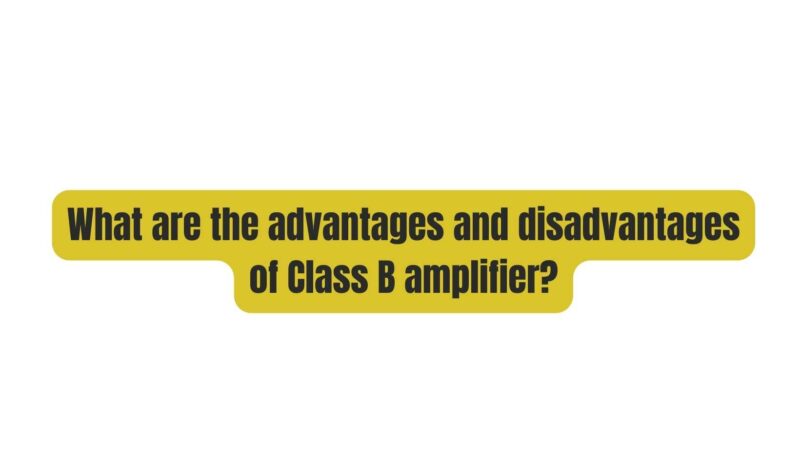Class B amplifiers have long been favored for their efficiency in amplifying signals, making them a common choice in various applications. However, like any technology, Class B amplifiers have their own set of advantages and disadvantages that engineers and users must consider. In this article, we will delve into the benefits and drawbacks of Class B amplifiers to provide a comprehensive overview of this amplifier class.
Advantages of Class B Amplifiers
1. High Efficiency
One of the primary advantages of Class B amplifiers is their high efficiency. These amplifiers are known for their ability to maximize power output while minimizing power dissipation in the form of heat. This efficiency makes Class B amplifiers well-suited for applications where power conservation is essential, such as in battery-powered devices or in situations where heat management is a concern.
2. Minimal Heat Generation
Due to their high efficiency, Class B amplifiers generate relatively minimal heat compared to less efficient amplifier classes like Class A. This property is particularly valuable in applications where heat can degrade performance, cause component wear, or lead to size and weight limitations. It’s common to find Class B amplifiers in compact and lightweight electronic devices.
3. Suitable for High-Power Applications
Class B amplifiers excel in high-power applications, making them a preferred choice for driving large speakers or powering devices that require substantial audio output. Their ability to deliver high power without excessive heat generation is a significant advantage in these scenarios.
4. Cost-Effective
Class B amplifiers are often more cost-effective to manufacture compared to some other amplifier classes, such as Class A. This cost advantage has made them a popular choice for consumer electronics and applications where cost is a primary consideration.
5. Reduced Quiescent Current
Class B amplifiers have low quiescent current (current drawn when there is no input signal), which contributes to their high efficiency. This property is particularly beneficial in battery-powered devices, as it extends battery life by minimizing power consumption during idle periods.
Disadvantages of Class B Amplifiers
1. Crossover Distortion
The most prominent disadvantage of Class B amplifiers is crossover distortion. This occurs at the point where the amplification switches from one transistor to another in a push-pull configuration. During this transition, there is a brief moment when neither transistor is conducting, resulting in a distortion in the output waveform.
1.1 Impact on Sound Quality
Crossover distortion can have a noticeable impact on sound quality, especially at low signal levels. Audiophiles and audio professionals often prefer other amplifier classes, such as Class A or Class AB, which have lower crossover distortion and are better suited for applications that demand high fidelity.
2. Limited Linearity
Class B amplifiers exhibit limited linearity, particularly near the crossover point where one transistor turns off, and the other turns on. This non-linearity can result in distortion and harmonic content in the amplified signal, affecting the accuracy of signal reproduction.
3. Biasing Challenges
Achieving precise biasing in Class B amplifiers is essential to minimize crossover distortion and maximize efficiency. Proper biasing is crucial to maintaining distortion at acceptable levels over various operating conditions and temperature ranges, which can be challenging.
4. Limited Frequency Response
Class B amplifiers may have a limited frequency response at higher power levels. As the output power increases, distortion can also increase, particularly in the higher frequency ranges. This limitation can impact the amplifier’s suitability for applications requiring high-frequency accuracy.
5. Push-Pull Configuration Requirement
Class B amplifiers typically require a push-pull configuration, necessitating the use of two complementary transistors (one NPN and one PNP) to handle the positive and negative halves of the input signal. This requirement adds complexity to the amplifier design and may increase manufacturing costs.
Conclusion
Class B amplifiers offer significant advantages in terms of efficiency, minimal heat generation, suitability for high-power applications, and cost-effectiveness. These strengths have made them a popular choice in a wide range of electronic devices and audio systems.
However, the primary disadvantage of Class B amplifiers, crossover distortion, cannot be ignored, particularly in applications where audio quality is paramount. Audiophiles and professionals often seek alternative amplifier classes, such as Class A or Class AB, to achieve higher sound quality and reduced distortion.
When selecting an amplifier for a specific application, it’s crucial to carefully consider the trade-offs between efficiency and sound quality. Advances in amplifier technology have led to the development of hybrid amplifier designs and feedback mechanisms aimed at mitigating crossover distortion, providing users with more options to meet their specific requirements. Ultimately, the choice of amplifier class should align with the priorities and objectives of the given application.

